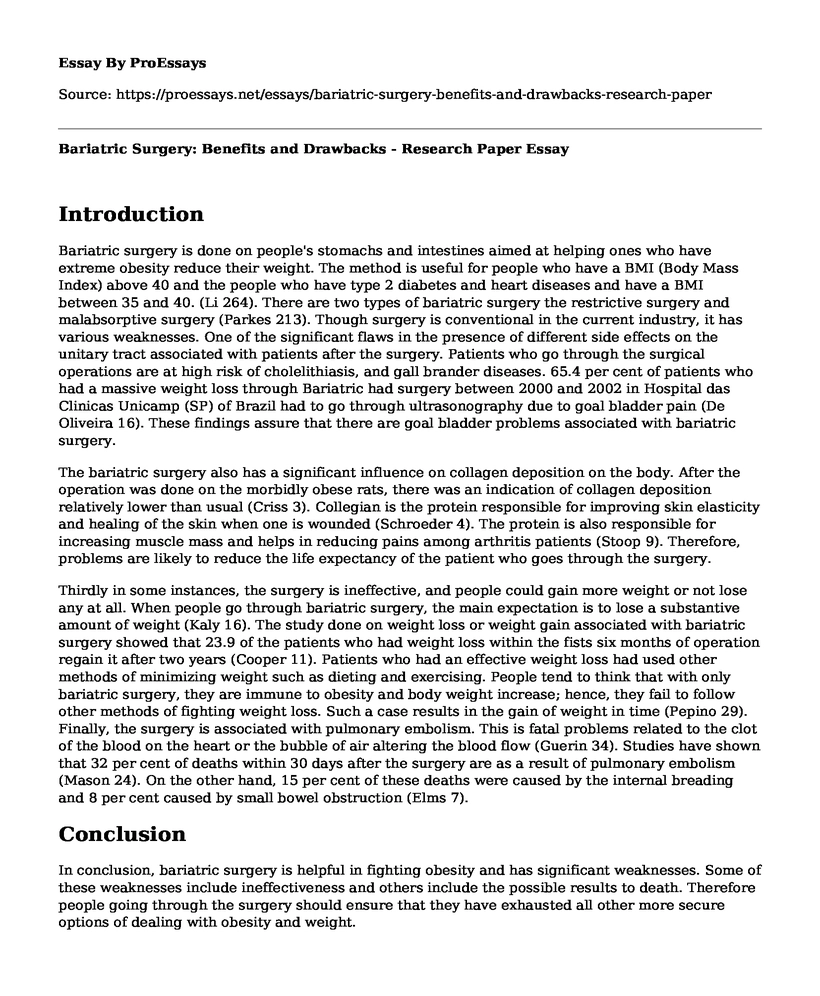Introduction
Bariatric surgery is done on people's stomachs and intestines aimed at helping ones who have extreme obesity reduce their weight. The method is useful for people who have a BMI (Body Mass Index) above 40 and the people who have type 2 diabetes and heart diseases and have a BMI between 35 and 40. (Li 264). There are two types of bariatric surgery the restrictive surgery and malabsorptive surgery (Parkes 213). Though surgery is conventional in the current industry, it has various weaknesses. One of the significant flaws in the presence of different side effects on the unitary tract associated with patients after the surgery. Patients who go through the surgical operations are at high risk of cholelithiasis, and gall brander diseases. 65.4 per cent of patients who had a massive weight loss through Bariatric had surgery between 2000 and 2002 in Hospital das Clinicas Unicamp (SP) of Brazil had to go through ultrasonography due to goal bladder pain (De Oliveira 16). These findings assure that there are goal bladder problems associated with bariatric surgery.
The bariatric surgery also has a significant influence on collagen deposition on the body. After the operation was done on the morbidly obese rats, there was an indication of collagen deposition relatively lower than usual (Criss 3). Collegian is the protein responsible for improving skin elasticity and healing of the skin when one is wounded (Schroeder 4). The protein is also responsible for increasing muscle mass and helps in reducing pains among arthritis patients (Stoop 9). Therefore, problems are likely to reduce the life expectancy of the patient who goes through the surgery.
Thirdly in some instances, the surgery is ineffective, and people could gain more weight or not lose any at all. When people go through bariatric surgery, the main expectation is to lose a substantive amount of weight (Kaly 16). The study done on weight loss or weight gain associated with bariatric surgery showed that 23.9 of the patients who had weight loss within the fists six months of operation regain it after two years (Cooper 11). Patients who had an effective weight loss had used other methods of minimizing weight such as dieting and exercising. People tend to think that with only bariatric surgery, they are immune to obesity and body weight increase; hence, they fail to follow other methods of fighting weight loss. Such a case results in the gain of weight in time (Pepino 29). Finally, the surgery is associated with pulmonary embolism. This is fatal problems related to the clot of the blood on the heart or the bubble of air altering the blood flow (Guerin 34). Studies have shown that 32 per cent of deaths within 30 days after the surgery are as a result of pulmonary embolism (Mason 24). On the other hand, 15 per cent of these deaths were caused by the internal breading and 8 per cent caused by small bowel obstruction (Elms 7).
Conclusion
In conclusion, bariatric surgery is helpful in fighting obesity and has significant weaknesses. Some of these weaknesses include ineffectiveness and others include the possible results to death. Therefore people going through the surgery should ensure that they have exhausted all other more secure options of dealing with obesity and weight.
Work Cited
Criss, C. N., et al. "The Effects of Weight Reduction Surgery on The Abdominal Wall Wound Healing Process." Journal of Surgical Research 179.2 (2013): 190.
Cooper, Timothy C., et al. "Trends in weight regain following Roux-en-Y gastric bypass (RYGB) bariatric surgery." Obesity surgery 25.8 (2015): 1474-1481.
De Oliveira, Carlos Iglezias Brandao, Elinton Adami Chaim, and Benedito Borges Da Silva. "Impact of rapid weight reduction on the risk of cholelithiasis after bariatric surgery." Obesity surgery 13.4 (2003): 625-628.
Elms, L., Moon, R. C., Varnadore, S., Teixeira, A. F., & Jawad, M. A.. "Causes of small bowel obstruction after Roux-en-Y gastric bypass: a review of 2,395 cases at a single institution." Surgical endoscopy 28.5 (2014): 1624-1628
Guerin, L., Couturaud, F., Parent, F., Revel, M. P., Gillaizeau, F., Planquette, B., ... & Sanchez, O. "Prevalence of chronic thromboembolic pulmonary hypertension after acute pulmonary embolism." Thrombosis and hemostasis 112.09 (2014): 598-605.
Kaly, Perry, et al. "Unrealistic weight loss expectations in candidates for bariatric surgery." Surgery for Obesity and Related Diseases 4.1 (2008): 6-10.
Li, Q., et al. "Metabolic effects of bariatric surgery in type 2 diabetic patients with body mass index< 35 kg/m2." Diabetes, Obesity and Metabolism 14.3 (2012): 262-270.
Mason, Edward E., et al. "Causes of 30-day bariatric surgery mortality: with emphasis on bypass obstruction." Obesity surgery 17.1 (2007): 9.
Parkes, Emmy. "Nutritional management of patients after bariatric surgery." The American journal of the medical sciences 331.4 (2006): 207-213.
Pepino, M. Y., Stein, R. I., Eagon, J. C., & Klein, S."Bariatric surgeryinduced weight loss causes remission of food addiction in extreme obesity." Obesity 22.8 (2014): 1792-1798.
Schroeder, Jacqueline A., Gregory S. Dapper, and Kenneth C. Olson. "Crossed-linked hyaluronic acid and collagen and uses thereof." U.S. Patent No. 8,697,044. 15 Apr. 2014.
Stoop, Jeroen N., et al. "Antibodies specific for carbamylated proteins precede the onset of clinical symptoms in mice with collagen-induced arthritis." PLoS One 9.7 (2014).
Cite this page
Bariatric Surgery: Benefits and Drawbacks - Research Paper. (2023, Apr 09). Retrieved from https://proessays.net/essays/bariatric-surgery-benefits-and-drawbacks-research-paper
If you are the original author of this essay and no longer wish to have it published on the ProEssays website, please click below to request its removal:
- Course Work Sample: ABC Health Care's Income Performance and Budgetary Recommendations
- Term Paper Example on Public Health: Orem's Self-care Model for Patients with Diabetes
- Research Paper on Endometriosis and Prostrate Cancer
- Applying the Tripartite Model of Nurse Educators Paper Example
- A Contemporary Nursing Leader: Dorothea Lynde Dix Paper Example
- Essay Sample on Can a Nurse Prescribe Medication to a Friend With No Medical History?
- Essay Example on COVID-19: One Million Infected in Under Three Months







